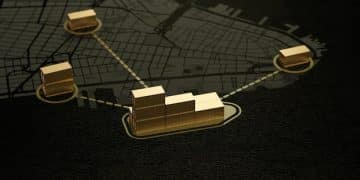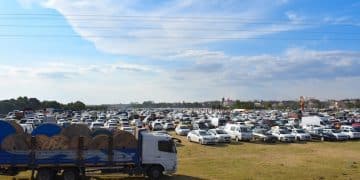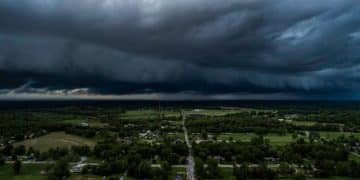Breaking: Federal Reserve Announces 0.75% Rate Hike – Impact on Mortgages & Loans

The Federal Reserve’s recent unexpected 0.75% interest rate hike fundamentally reshapes the financial landscape, directly influencing mortgage rates, consumer loan costs and broader economic stability, prompting immediate adjustments for both lenders and borrowers across the United States.
In a move that caught many by surprise, the Federal Reserve has announced an unexpected interest rate hike of 0.75% – impact on mortgages and loans is immediate and far-reaching. This significant adjustment signals the Fed’s aggressive stance against persistent inflation, but what does it truly mean for the average American consumer and the broader economy?
Understanding the Federal Reserve’s Decision
The Federal Reserve, often referred to as “the Fed,” operates as the central banking system of the United States. Its primary mandates include maintaining maximum employment, stable prices, and moderate long-term interest rates. To achieve these goals, the Fed utilizes various monetary policy tools, with adjusting the federal funds rate being one of the most prominent.
This latest 0.75% increase in the federal funds rate marks a substantial shift from previous, more incremental adjustments. This aggressive action underscores the Fed’s growing concern over the persistently high inflation rates currently plaguing the U.S. economy. For months, inflation has remained stubbornly above the Fed’s long-term target of 2%, eroding purchasing power and creating economic uncertainty for households and businesses alike.
The Urgency Behind the Hike
Several economic indicators likely played a crucial role in the Fed’s decision to implement such a significant rate hike. These include:
- Persistent Inflation: Consumer Price Index (CPI) and Personal Consumption Expenditures (PCE) data have consistently shown elevated inflation across various sectors, from energy and food to housing and services.
- Strong Labor Market: Despite inflation, the labor market has remained relatively robust, with low unemployment rates and consistent wage growth. While positive, this strength can also contribute to inflationary pressures if demand outstrips supply too significantly.
- Global Economic Factors: Geopolitical events, supply chain disruptions, and commodity price volatility stemming from international conflicts have also contributed to inflationary pressures, making the Fed’s task more complex.
- Inflation Expectations: The Fed closely monitors inflation expectations among consumers and businesses. If these expectations become unanchored, it can lead to a self-fulfilling prophecy, making inflation even harder to control.
This unexpected rate hike sends a strong signal that the Fed is committed to bringing inflation under control, even if it means potentially slowing economic growth. The magnitude of the increase reflects a more urgent and decisive approach than many analysts had anticipated, indicating the Fed’s determination to restore price stability.
By raising interest rates, the Fed aims to cool down aggregate demand in the economy. Higher borrowing costs discourage spending and investment, thereby reducing inflationary pressures. While this approach is necessary for long-term economic health, it also carries potential risks, which will be explored in subsequent sections.
Immediate Repercussions on Mortgages
For millions of Americans either looking to buy a home or refinance an existing mortgage, the Federal Reserve’s unexpected rate hike brings immediate and often unwelcome news. The federal funds rate directly influences the prime rate, which in turn impacts a wide array of consumer lending products, most notably mortgages.
Mortgage rates, particularly for popular 30-year fixed-rate loans, tend to move in tandem with general interest rate trends. When the Fed raises its benchmark rate, the cost of borrowing for banks increases. This increased cost is then passed on to consumers in the form of higher interest rates on loans, including home loans.
Impact on New Homebuyers
For those in the market to purchase a new home, the implications are stark. A higher interest rate on a mortgage means a higher monthly payment for the same loan amount. This reduces purchasing power, as homebuyers will either need to spend more per month or reduce the size of the loan they can afford. Consider this:
- Reduced Affordability: Even a modest increase in mortgage rates can significantly impact the total cost of a home over its lifespan, making homeownership less accessible for some potential buyers.
- Higher Monthly Payments: A principal and interest payment on a $300,000 mortgage will be noticeably higher with a 6% interest rate compared to a 5% rate, potentially stretching household budgets.
- Cooling Housing Market: Increased mortgage costs can contribute to a slowdown in the housing market, as demand may decrease and competition among buyers lessens. This could potentially lead to a moderation in home price appreciation, although that remains to be seen in various local markets.
Many prospective homebuyers who were pre-approved for specific loan amounts at lower rates may now find those rates are no longer available or that their approved amount is insufficient to purchase the homes they desire. This necessitates a recalculation of their budget and potentially a reassessment of their homeownership timeline.
Impact on Refinancing
Existing homeowners who have been considering refinancing their mortgages may also be impacted. For those with adjustable-rate mortgages (ARMs), an interest rate hike means that their monthly payments could increase when their adjustable period resets. While fixed-rate mortgage holders are protected from direct increases, the incentive to refinance to a lower rate diminishes significantly as rates rise.
Unless a homeowner secured their current fixed rate at a considerably higher percentage in the past, or if their financial circumstances have drastically improved, refinancing might no longer offer the substantial savings it once did. The higher the current market rates compared to their existing loan, the less appealing refinancing becomes.

Effects on Consumer Loans and Credit
Beyond mortgages, the Federal Reserve’s interest rate hike cascades through the entire spectrum of consumer lending, influencing everything from credit card APRs to auto loans and personal lines of credit. Just as with mortgages, the underlying mechanism is that the cost of borrowing for banks increases, and these increased costs are passed on to consumers.
For individuals carrying balances on their credit cards, a rate hike can translate directly into higher minimum payments and increased overall debt burdens. Most credit cards have variable interest rates tied to the prime rate, which is directly influenced by the federal funds rate. As the prime rate goes up, so does the interest charged on credit card debt. This makes paying off balances more challenging and can trap consumers in a cycle of accumulating interest.
Impact on Various Loan Types
- Credit Cards: As mentioned, variable APRs on credit cards are typically tied to the prime rate. Consumers with existing credit card debt will likely see their interest rates tick up, meaning a larger portion of their payments will go towards interest rather than principal.
- Auto Loans: While auto loan rates are not as directly tied to the federal funds rate as mortgages or credit cards, they are still influenced by the broader interest rate environment. New auto loans will likely become more expensive, increasing monthly payments for car buyers. This could slow down vehicle sales, especially for new cars.
- Personal Loans and Lines of Credit: These types of loans, often unsecured, also tend to see their interest rates increase following a Fed hike. For individuals seeking personal loans for consolidation, home improvements, or other needs, the cost of borrowing will be higher. This can make these financial tools less attractive or accessible.
- Student Loans (Variable Rate): While federal student loan rates are fixed annually, private student loans with variable rates could see an increase in their interest payments. This is a crucial consideration for borrowers with these types of loans.
The collective impact of higher rates across these diverse loan categories is a tightening of credit conditions for the average consumer. Borrowing becomes more expensive, which is precisely the Fed’s intention: to curb inflation by reducing demand. However, this also means that consumers will have less discretionary income, as more of their budget is allocated to debt servicing. This squeeze on consumer budgets can lead to a reduction in overall spending, which, while beneficial for inflation control, can also temper economic growth.
Consumers are therefore encouraged to review their outstanding debts, especially those with variable interest rates. Prioritizing repayment of high-interest debts like credit card balances becomes even more critical in a rising interest rate environment to minimize the financial impact on household budgets.
Broader Economic Implications and Outlook
The Federal Reserve’s decision to implement a significant interest rate hike ripples far beyond individual mortgages and consumer loans, affecting the broader economic landscape. This aggressive monetary tightening is a calculated risk taken by the Fed to combat inflation, but it comes with a range of potential consequences for economic growth, employment, and investment.
One of the primary goals of raising interest rates is to slow down economic activity by making borrowing more expensive, thereby reducing overall demand in the economy. While this is expected to help cool inflationary pressures, it also carries the risk of dampening economic growth and potentially leading to a recession. A “soft landing,” where inflation is brought under control without a significant economic downturn, is the desired outcome, but it is a challenging balancing act.
Market Reactions and Investor Sentiment
Financial markets typically react swiftly and often dramatically to Fed announcements. An unexpected rate hike can lead to increased volatility in stock and bond markets:
- Stock Market: Higher interest rates can make borrowing more expensive for companies, potentially reducing their profits and growth prospects. This often leads to a sell-off in growth-oriented stocks and a shift towards value stocks or more stable assets.
- Bond Market: Bond prices typically fall when interest rates rise, as newly issued bonds offer higher yields, making existing lower-yield bonds less attractive. This can create challenges for investors holding long-term bonds.
- U.S. Dollar Strength: Higher U.S. interest rates can attract foreign investment seeking better returns, leading to an appreciation of the U.S. dollar against other currencies. While this makes imports cheaper, it can make American exports more expensive, potentially impacting trade balances.
Investor sentiment can also shift, becoming more cautious in an environment of rising rates and potential economic slowdown. This can lead to reduced capital expenditures by businesses and less venture capital funding for startups, further impacting economic dynamism.
Impact on Employment and Business Investment
If economic activity slows too much, there is a risk of increased unemployment. Companies may postpone hiring or even implement layoffs if consumer demand weakens significantly and their borrowing costs increase. This poses a challenge to the Fed’s dual mandate of controlling inflation while also maintaining maximum sustainable employment.
Furthermore, businesses may delay or scale back their investment plans due to higher borrowing costs and increased economic uncertainty. Reduced business investment can stifle innovation and long-term productivity growth. The Fed’s hope is that by acting decisively now, they can restore price stability and create a more predictable environment for long-term investment, even if there’s short-term pain.
The path forward will involve careful monitoring of economic data by the Fed, including inflation metrics, employment reports, and GDP growth. Future interest rate decisions will largely hinge on how these indicators evolve in response to the current monetary policy adjustments. Analysts will be scrutinizing every piece of data for clues about the Fed’s next moves and the overall trajectory of the U.S. economy.
Strategies for Consumers to Navigate Rising Rates
In an environment of rising interest rates, proactively managing personal finances becomes more critical than ever. While the Federal Reserve’s actions are aimed at macroeconomic stability, individual consumers must adopt strategies to mitigate the impact on their household budgets and long-term financial goals.
The immediate effect of higher rates is increased borrowing costs, meaning that any new debt incurred will be more expensive and existing variable-rate debt will see higher payments. Understanding these dynamics is the first step towards formulating an effective financial strategy.
Minimizing Debt and Maximizing Savings
One of the most effective strategies is to focus on reducing high-interest debt. Prioritizing the repayment of credit card balances, personal loans, and other variable-rate obligations can save a significant amount in interest payments over time. Consider these approaches:
- Debt Snowball or Avalanche: Employ strategies like the debt snowball (paying off smallest balances first for psychological wins) or the debt avalanche (paying off highest interest rate debt first for maximum savings) to systematically eliminate debt.
- Refinance Fixed-Rate Debt (with caution): If you have high-interest, fixed-rate debt, assess if there are still opportunities to refinance to a lower fixed rate, though these opportunities are diminishing. This is less about saving on higher new rates and more about locking in a lower rate before variable rates rise further.
- Boost Emergency Savings: Higher interest rates also mean that savings accounts and Certificates of Deposit (CDs) offer better returns. Increasing contributions to an emergency fund held in a high-yield savings account provides a dual benefit: a safety net for unexpected expenses and a modest return on your liquid assets.
By shedding high-cost debt and building up liquid savings, consumers create a stronger financial buffer against future economic uncertainties and rising costs.
Adapting Spending Habits and Investment Approaches
Beyond debt management and savings, adjusting spending habits and considering investment approaches can also offer a degree of protection:
Review your budget for areas where spending can be reduced. This might involve cutting back on discretionary spending, finding more affordable alternatives for regular purchases, or negotiating better deals on services like internet or insurance. Every dollar saved reduces the need to borrow and frees up funds for debt repayment or savings.
When it comes to investments, a rising rate environment typically favors assets that provide income or have less sensitivity to interest rate fluctuations. Consider consulting a financial advisor to re-evaluate your portfolio. They might suggest:
- Short-term Bonds or CDs: These instruments become more attractive as rates rise, offering better yields without locking up money for long periods.
- Dividend Stocks: Companies with strong balance sheets and a history of consistent dividend payments can offer a degree of stability and income during volatile periods.
- Real Estate (with caution): While mortgages are more expensive, some investors might still see real estate as a long-term hedge against inflation, though careful analysis of local market conditions is crucial.
The key takeaway is to remain agile and informed. Financial planning is not a static exercise; it requires continuous adjustment based on prevailing economic conditions. By taking proactive steps, consumers can navigate the challenges posed by rising interest rates and position themselves for greater financial resilience.
Historical Context of Fed Rate Hikes
To fully appreciate the significance of the Federal Reserve’s recent 0.75% interest rate hike, it is helpful to place it within historical context. The Fed has a long history of using interest rate adjustments as a primary tool to manage the economy, often in response to inflationary pressures or economic downturns. These actions are rarely unprecedented, but their magnitude and timing always reflect the unique challenges of the current economic climate.
Looking back, there have been several periods where the Fed implemented aggressive rate hikes to combat high inflation. The most cited example is the early 1980s under Chairman Paul Volcker. Facing double-digit inflation, Volcker famously pushed the federal funds rate to nearly 20%, a draconian measure that successfully broke the back of inflation but also triggered a severe recession. While the current environment is different, Volcker’s actions serve as a stark reminder of the lengths to which the Fed may go to restore price stability.
Past Cycles of Rate Increases
Beyond the Volcker era, other notable periods of concerted rate increases include:
- Mid-1990s: The Fed, under Alan Greenspan, preemptively raised rates in 1994-1995 to head off inflationary pressures during a period of strong economic growth. This “soft landing” is often cited as a successful example of monetary policy.
- Mid-2000s: From 2004 to 2006, the Fed gradually raised rates to address concerns about overheating in the economy and potential asset bubbles, particularly in the housing market, leading up to the 2008 financial crisis.
- Late 2010s: After the Great Recession, the Fed began a gradual normalization of monetary policy, raising rates incrementally from near-zero levels starting in late 2015 and continuing until late 2018, before pausing due to global economic slowdown concerns.
Each of these cycles had its own unique triggers and outcomes, but they all demonstrate the Fed’s consistent reliance on rate adjustments to influence economic conditions. The current aggressive stance, marked by a 0.75% hike, is unusual in its magnitude for a single meeting in recent decades, outside of crisis interventions.
Compared to the gradual “on-the-move” strategy seen in many past cycles, the present environment suggests a more urgent need for intervention. The persistence and breadth of inflation across various sectors of the economy have pushed the Fed to accelerate its tightening pace, indicating a belief that waiting too long could lead to even greater economic instability down the line.
Understanding these historical precedents helps to contextualize the Fed’s current hawkish posture. It underscores the severity of the inflation challenge and the Fed’s determination to bring it under control, even if the path ahead is uncertain and carries potential for economic deceleration.
Future Outlook and Expert Predictions
The Federal Reserve’s unexpected 0.75% interest rate hike has ignited widespread speculation among economists, analysts, and market participants regarding the future trajectory of monetary policy and its potential impact on the U.S. economy. While no one can predict the future with absolute certainty, expert predictions offer valuable insights into what may lie ahead.
The consensus among many economists is that this hike is unlikely to be the last. Given the Fed’s stated commitment to bringing inflation down to its 2% target, further rate increases are widely anticipated in the coming months. The pace and magnitude of these future hikes, however, will largely depend on incoming economic data, particularly inflation figures and employment reports.
Potential Scenarios for Monetary Policy
Several scenarios are being discussed regarding the Fed’s next steps:
- Continued Aggressive Tightening: If inflation remains stubbornly high or even accelerates, the Fed might opt for additional large rate hikes (e.g., 0.50% or even another 0.75%) at subsequent meetings. This aggressive path would signal a strong commitment to price stability but carries a higher risk of triggering a recession.
- Measured Hikes: If inflation shows signs of peaking and beginning to moderate, the Fed might revert to more traditional, smaller increments (e.g., 0.25%). This “wait and see” approach would allow them to assess the impact of previous hikes while continuing to tighten monetary policy.
- A Pause (Less Likely in the Short Term): A pause in rate hikes would only be considered if economic data deteriorated significantly, indicating a sharp slowdown or recession, or if inflation showed a clear and sustained downward trend. Most experts view this as unlikely in the immediate future following such a strong signal of intent.
The Fed’s communication will be critical in guiding expectations. Forward guidance from Chairman Jerome Powell and other Fed officials will be closely scrutinized for clues about their evolving outlook and policy intentions. Any deviation from anticipated statements could lead to significant market reactions.
Economic Trajectory and Recession Risk
A key focus of current predictions is the likelihood of a recession. The Fed’s goal is to engineer a “soft landing,” where inflation is brought under control without a severe economic downturn. However, many experts believe that achieving this will be challenging, and some degree of economic slowdown or even a mild recession might be an unavoidable consequence of aggressive tightening.
Factors that will influence the economic trajectory include global supply chain improvements, commodity price movements, geopolitical stability, and consumer spending resilience. If supply-side issues ease and commodity prices stabilize, it could assist the Fed’s efforts. Conversely, continued external shocks could complicate the picture:
- Consumer Spending: A significant slowdown in consumer spending due to higher prices and borrowing costs would increase recessionary pressures.
- Corporate Earnings: Higher rates and slower growth could impact corporate earnings, leading to reduced investment and potential layoffs.
- Global Growth: A slowdown in global economic growth could also feedback into the U.S. economy, impacting exports and overall demand.
In essence, the future outlook is one of continued uncertainty and delicate balancing acts. The Fed remains committed to tackling inflation, and its future actions will be dictated by the evolving economic landscape, with implications for every sector of the U.S. economy.
| Key Point | Brief Description |
|---|---|
| 📊 Fed’s Goal | To fight inflation and stabilize prices by increasing borrowing costs. |
| 🏠 Mortgage Impact | Higher rates mean increased monthly payments for new loans and reduced affordability. |
| 💳 Consumer Loans Affected | Credit card APRs, auto loans, and personal loans will also see higher interest rates. |
| 📉 Economic Outlook | Risk of slower economic growth or recession as rates rise to curb demand. |
Frequently Asked Questions
The Federal Reserve implemented this significant rate hike primarily to combat persistently high inflation, which has been eroding purchasing power for consumers. This aggressive move signals their determination to bring inflation back down to their target of 2% by cooling economic demand.
If you have a fixed-rate mortgage, your current monthly payments will not change. However, if you have an adjustable-rate mortgage (ARM), your payments could increase when your interest rate resets according to the terms of your loan. Refinancing new mortgages will also be more expensive now.
Most credit card interest rates are variable and tied to the prime rate, which directly reflects the federal funds rate. Therefore, consumers carrying a balance on their credit cards will likely see their interest rates increase, leading to higher minimum payments and a greater burden of interest over time.
The Fed aims for a “soft landing,” where inflation is controlled without a severe economic downturn. However, aggressive rate hikes increase the risk of an economic slowdown or recession. The outcome will depend on how quickly inflation responds and other economic factors unfold in the coming months.
Consumers can prepare by prioritizing the repayment of high-interest, variable-rate debt like credit card balances. It’s also wise to boost emergency savings, review and adjust household budgets, and consider consulting a financial advisor to reassess investment strategies for a rising rate environment.
Conclusion
The Federal Reserve’s unexpected 0.75% interest rate hike is a decisive step in its ongoing battle against inflation, signaling a commitment to restore price stability even if it means tempering economic growth. This action immediately translates into higher costs for new mortgages and consumer loans, impacting everything from housing affordability to credit card debt. While the Fed aims for a soft landing, consumers and businesses must brace for potential economic shifts. Proactive financial planning, debt reduction, and a watchful eye on economic indicators will be crucial for navigating this evolving landscape. The path ahead remains uncertain, but the Fed’s intent is clear: to rein in inflation, with significant implications for every American’s financial future.





